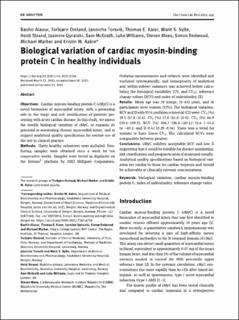| dc.description.abstract | Objectives
Cardiac myosin-binding protein C (cMyC) is a novel biomarker of myocardial injury, with a promising role in the triage and risk stratification of patients presenting with acute cardiac disease. In this study, we assess the weekly biological variation of cMyC, to examine its potential in monitoring chronic myocardial injury, and to suggest analytical quality specification for routine use of the test in clinical practice.
Methods
Thirty healthy volunteers were included. Non-fasting samples were obtained once a week for ten consecutive weeks. Samples were tested in duplicate on the Erenna® platform by EMD Millipore Corporation. Outlying measurements and subjects were identified and excluded systematically, and homogeneity of analytical and within-subject variances was achieved before calculating the biological variability (CVI and CVG), reference change values (RCV) and index of individuality (II).
Results
Mean age was 38 (range, 21–64) years, and 16 participants were women (53%). The biological variation, RCV and II with 95% confidence interval (CI) were: CVA (%) 19.5 (17.8–21.6), CVI (%) 17.8 (14.8–21.0), CVG (%) 66.9 (50.4–109.9), RCV (%) 106.7 (96.6–120.1)/−51.6 (−54.6 to −49.1) and II 0.42 (0.29–0.56). There was a trend for women to have lower CVG. The calculated RCVs were comparable between genders.
Conclusions
cMyC exhibits acceptable RCV and low II suggesting that it could be suitable for disease monitoring, risk stratification and prognostication if measured serially. Analytical quality specifications based on biological variation are similar to those for cardiac troponin and should be achievable at clinically relevant concentrations. | en_US |
